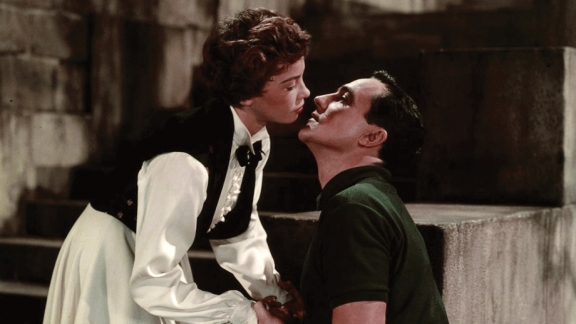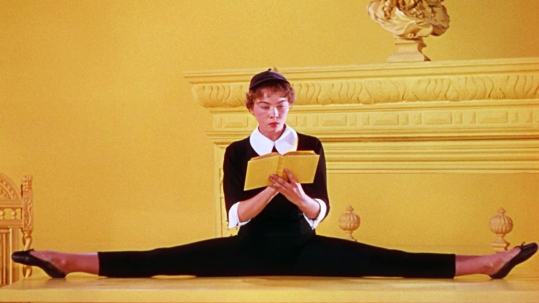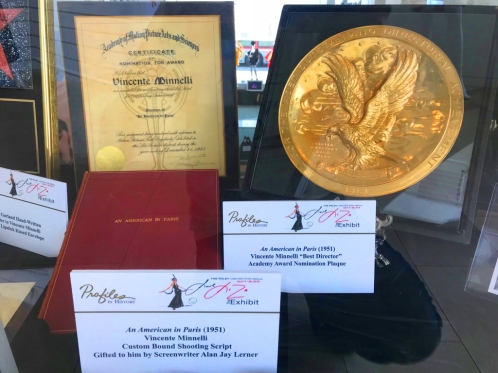

Often overlooked and often compared to its more iconic counterpart, Singin’ in the Rain, is one of my favorite pictures to watch on days when there’s nothing to do or when there’s too much to do. If Singin’ in the Rain is that classic Hollywood romp you watch late at night until 1:30am in the morning (and what a lovely morning!), then An American in Paris is its daytime Parisian companion piece.
The charm and positive attitude of An American in Paris is what always gets to me. Hollywood will always be Hollywood with its sawdust soundstages and thin wooden sets, but the old-world charm of the Paris setting completely transports you to a land of culture where everyone is either in the arts or sipping espressos in the Latin Quarter.
Sure, it wasn’t actually filmed in Paris, but look at the attention to detail. It’s almost better than the real Paris. The Seine looks deeper, the skies brighter, and the cafés more caffeinated. When the stars emerge from their sleepy hiding nooks, the cobblestones hum with excitement. With every tap-tap-tap of the foot, every pirouette and every sway, they anticipate the dance of love.
Gene Kelly plays Jerry Mulligan, an American painter trying to get by in post-war Paris. He’s the usual Gene Kelly archetype: positive, exuberant, full of charm and charisma, dancing his way through the hearts of Parisians everywhere he goes. One day he runs into Milo Roberts (Nina Fochs) who becomes his rich benefactor. He’s willing to trade off on his good looks for her money and encouragement until he meets the young ingénue Lise Bouvier (Leslie Caron) at a bar one evening. In that classic MGM fashion, he immediately becomes smitten. Despite the adoring patronage of one woman and the reluctance of another, things are further complicated when it’s revealed that Jerry’s friend Henri Baurel (Georges Guétary) is involved with Lise.

What’s so romantic about this Parisian era versus earlier decades? Kelly and director Vincente Minnelli could have made a Lost Generation film, or even La Belle Époque Paris. But ’50s Paris was something new, something the music of George Gershwin foreshadowed. This was the Paris of Allen Ginsberg, of William S. Burroughs, George Whitman, the Beat Generation and The Paris Review. Where all the poets wore black and snapped their fingers in smokey bars.
The plot, of course, is only an excuse to get to the wonderful musical numbers. I Got Rhythm showcases the positivity of the Latin Quarter and the little French schoolchildren, who sing along and enunciate to Jerry’s American bravado. Love Is Here to Stay is already a romantic Gershwin melody, but the romance is punctuated even more by the mere existence of the Left Bank. Very few movies have entered into this exclusive category, I’m Through with Love from the 1999 film Everyone Says I Love You being one of the rare exceptions.


Leslie Caron. Oh, Leslie Caron. What can you say about Leslie Caron that doesn’t make you fall in love with her all over again? If there was a personification of Parisian puppy love, it would look like Leslie Caron. She embodied the embrace of innocent romance that only Paris could ever conjure. Lise Bouvier works as a perfume girl, but Caron brought to the character a kind of rhapsodic ballet-like litheness that made her so exceptional. With her natural curly hair, her wide smile, and her European coyness, she was proof that talent existed outside of Hollywood, U.S.A.


You can’t go very far in talking about the music or the humor without singing the praises of Oscar Levant as Adam Cook. He’s the complete antithesis to Donald O’Connor’s Cosmo Brown. While Cosmo is pip, upbeat, and bursting at the seams with a stick-like energy, Adam Cook is lethargic; he’s tired, grumpy, and the kind of curmudgeon who doesn’t care – yet deep down, he values his heart of gold. His face reflects his sourpuss attitude – the kind of tortured artist you always dream of meeting. Every comeback and retort is masterfully strung together – he growls insults and yearns to be the kind of composer that Beethoven wishes he was.

The Technicolor backdrops and dazzling sets more than make up for the lack of on-location shots. Ultimately what it is is a dreamy fantasy of what we imagine Paris to be, no more evident than in the final dance sequence, when the crayon-colored cut-outs and playful Broadway sets evoke something out of a Ludwig Bemelmans storybook. It’s long and indulgent, but it’s supposed to encompass everything we expect of Paris, as well as play out George Gershwin’s entire suite from beginning to end.

I’m often comforted by this film because it knows not to encourage pathos in its soul. While pathos certainly enriches storytelling, as it does in Singin’ in the Rain (which ends with the happiest of tear-jerking), some pictures can be exuberant for the sake of exuberance. We’re in the joyous ride of these characters’ experiences, and when they smile, so then do we. I like that the picture is electric and atmospheric. I like that it makes us an alert spectator of Paris and a willing participant in its triumph of jolly ebullience.

When I visited the Love, Liza exhibit last month at the Paley Center (which you can read about here), I also happened upon some priceless artifacts from An American in Paris. Liza is, of course, the daughter of Vincente Minnelli and Judy Garland, and she kept these treasured belongings for over half a century. It was a privilege and a delight to see them as they may possibly never be seen in public ever again.
An American in Paris is so incredibly charming and cheery. It’s drenched in a kind of enthusiastic sunlight that welcomes you into a golden morning, and for that reason, it’s my comfort movie.
To read the other blogposts celebrating National Classic Movie Day, please click here and follow Classic Comfort Movie Blogathon host Classic Film & TV Café!
“All images from An American in Paris (1951) are Copyright © Metro-Goldwyn-Mayer Studios Inc.”





Lovely. It is the presentation of the musical pieces, and the wonderful final ballet that makes me stick with An American in Paris, but my appreciation for the characters has been enhanced by your article.
LikeLiked by 1 person
Thank you, Patricia! The final ballet is so grand – what other film has ever played a musical composition in its entirety like this? Superb!
LikeLike
Gershwin, Kelly and Paris – how can you go wrong? It’s a beautiful film that does take you to a comfortable place. Great choice!
LikeLiked by 1 person
So very comfortable. The greatest composer, the greatest dancer, the greatest city. Thanks for reading!
LikeLike
Your review is full of joy for this classic musical, and makes me want to watch it again, as I must say I didn’t fully appreciate it the first time I saw it. Not sure why. I will pay special attention to the sets that are more Parisian than Paris!
LikeLiked by 1 person
You must rewatch it, Jocelyn! It’s better than the real Paris…if that’s even possible!
LikeLike
I recently purchased this on DVD and yet to watch it. With the weekend coming, I know what I will be doing! So glad I read this review, which has inspired me to view it. A great review! Many thanks!
LikeLiked by 1 person
The movie will inspire you much than my little review but if I can lead you down that road, then my work is done. Thanks for reading!
LikeLiked by 1 person
I never thought about it before, but I agree that Paris has never looked lovelier than in this film.
So glad you posted the “I’ve Got Rhythm” clip. I’ll be humming that for the rest of the day, happily.
LikeLiked by 1 person
It’s got to be the best version of “I’ve Got Rhythm”, don’t you think? The schoolchildren are great, and I love it when Kelly imitates Chaplin’s waddle, and the shouts of the children: “Charlot!”
LikeLiked by 1 person
Wonderful review, great choice. Paris is, after all, a state of mind. This film takes that saying and runs…uh, dances away with it. I love the ballet at the end and the Stairway to Heaven number always makes me smile. Gene Kelly never looked so beautiful as he does here and in SINGING IN THE RAIN. He really was a gorgeous man. Leslie Caron was adorable and just when you think she might be too young for Gene, there’s that fountain dance routine.
LikeLiked by 1 person
Thanks, Yvette! “Stairway to Paradise” doesn’t necessarily need to be in the film, but it shows a lot of generosity on Kelly and Minnelli to give Georges Guétary that number. Paris is truly one of the nicest states of mind.
LikeLike
LOVE this film. And what a marvelous review! You highlighted everything that I adore about it.
When I was studying in Paris a few summers ago, I was so disappointed by the non-stop rain because it overflowed the Seine and I couldn’t walk alongside it like Lisa and Jerry did. One of these days!
LikeLiked by 1 person
Aw, that’s too bad! But you know what? There’s still something magical about Paris in the rain… Walking across the Left Bank full of books, passing by the Grand Palais and watching the raindrops roll down its glassy walls…truly the City of Lights. Thanks for reading, Michaela!
LikeLike
It’s a more challenging, more ambitious film than SINGIN’ IN THE RAIN and that’s one of the reasons why it’s not as beloved (plus SINGIN’ is about movies). But there’s no doubt that it features some of the most original dance numbers in Hollywood history.
LikeLike
Challenging, ambitious, and more lavish, perhaps at the expense of emotional sympathy – but the production value is so high and the tone set so whimsically, it takes you on a ride.
LikeLike
Pingback: Top 100 Movie Review: #68 – An American in Paris (1951) – The Top 100 Reviews